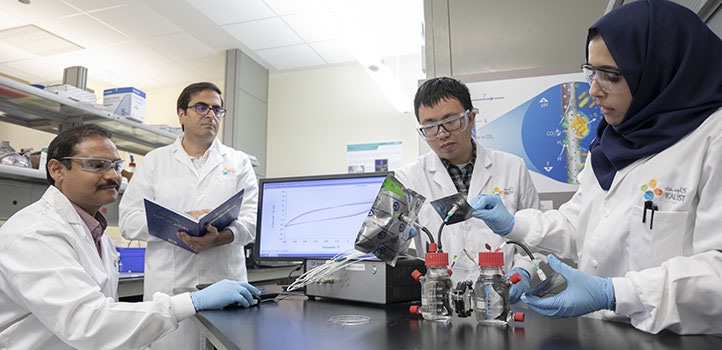Dec 10 2018
Microbes could become vital allies in the worldwide efforts to curtail carbon emissions and avoid hazardous climate change. A family of microbes known as chemolithoautotrophs consume CO2 through their natural metabolism and expel small organic molecules as a byproduct. These microbes could be recruited to convert industrial CO2 emissions into useful chemicals, thanks to a new theory put forth by Pascal Saikaly and his team at KAUST.
 The microbial electrosynthesis cell that turns carbon dioxide gas into valuable chemicals was created by (L-R) Krishna Katuri, Pascal Saikaly, Bin Bian, and Manal Alqahtani. (© 2018 KAUST)
The microbial electrosynthesis cell that turns carbon dioxide gas into valuable chemicals was created by (L-R) Krishna Katuri, Pascal Saikaly, Bin Bian, and Manal Alqahtani. (© 2018 KAUST)
Chemolithoautotrophs are typically found in caves, in the deep sea, and hydrothermal vents, where conventional energy sources, such as sunlight and organic carbon, are missing. “The microbes obtain their energy from the oxidation of inorganic compounds, such as hydrogen, iron, and sulfur,” explains Bin Bian, a Ph.D. student from Saikaly’s team. The microbes strip the inorganic compounds of electrons while absorbing CO2 and reducing it to organic products as part of the process.
To harness the capabilities of chemolithoautotroph for recycling CO2 emissions into valuable chemicals, scientists supply electrons to the microbes in a process known as microbial electrosynthesis (MES). Typically, MES reactors have grown chemolithoautotrophs on a submerged flat-sheet cathode and bubbled CO2 gas into the solution, but this system has two crucial limitations, explains Manal Alqahtani, also a Ph.D. student in the team. Flat-sheet cathodes are hard to scale up and CO2 gas has weak solubility.
The team designed an alternative MES reactor with cathodes made from stackable, cylindrical porous nickel fibers that Saikaly’s group had earlier applied to recover energy and water from wastewater1. CO2 is pumped through each cylinder, and electrons flow along it.
Using this architecture, we directly deliver CO2 gas to chemolithoautotrophs through the pores in the hollow fibers. We provided electrons and CO2 simultaneously to chemolithoautotrophs on the cathode surface.
Manal Alqahtani, Ph.D. Student, KAUST.
In Alqahtani’s preliminary study, methane-producing microbes were able to turn CO2 to methane with 77% efficiency, compared to 3% efficiency with a traditional design.
A continuation study enhanced performance further by coating the electrodes with carbon nanotubes2. These supplied a more biocompatible surface for microbial growth, and enhanced the hollow fibers’ CO2 adsorption capability 11-fold. “Additionally, the nanotubes enhanced the electron transfer from electrode to chemolithoautotrophs,” Bin says. In tests using acetate-producing microbes, creation of the chemical nearly doubled when the nanotube coating was applied, he says.
Alqahtani’s continuing work includes exploring easier methods to develop porous cylindrical cathodes, while Bian is enhancing CO2 flow rates and investing renewable MES energy sources, such as solar. Both students acknowledge the significant contribution made to their work by Krishna Katuri, a research scientist in Saikaly’s lab.
Carbon emissions smoked
Helpful microbes inhale CO2 through a porous cylindrical electrode and exude useful chemicals. (© 2018 KAUST)
References
1Alqahtani, M.F., Katuri, K.P., Bajracharya, S., Yu, Y., Lai, Z. & Saikaly, P.E. Porous hollow fiber nickel electrodes for effective supply and reduction of carbon dioxide to methane through microbial electrosynthesis. Advanced Functional Materials, advance online publication, 06 September 2018.
2Bian, B., Alqahtani, M.F., Katuri, K.P., Liu, D., Bajracharya, S., Lai, Z. & Saikaly, P.E. Porous nickel hollow fiber cathodes coated with CNTs for efficient microbial electrosynthesis of acetate from CO2 using Sporomusa ovata. Journal of Materials Chemistry A 6, 17201 (2018).